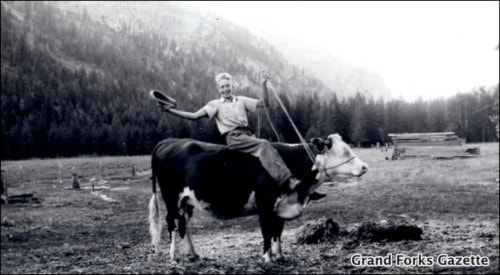Over the last 76 years, life-long North Fork resident Carl Stone has not only seen many of the changes affecting the lives of Boundary ranchers and farmers but has experienced many of them, good and bad, himself.
The horses he once learned to hitch to wagons and ploughs have been replaced by tractors; the homesteads and town sites he knew in his youth, that had dotted the Granby River valley from the beginning of the 20th century, have all slowly become overgrown and vanished.
Only a few men and women who, like Carl, were raised in the North Fork remember the first families that built the log houses and cleared the land long before there was electricity or telephones or paved roads.
“I was fortunate to have known many of the original settlers,” Carl says, “and to have heard their stories and remembered and recorded them over the years.”
Carl is highly regarded as a local historian in the Boundary area. He has his own archive of photographs, articles and publications that recount the early days of the area, and his personal history is both interesting and indicative of a time when life was different indeed, and significantly more precarious.
“I should have been born in Phoenix,” Carl says, “on the homestead my grandfather had where they later put the tailings pond for the mine but a neighbour rode on horseback to Grand Forks to get old Doc Kingston, who drove his car up and took my mother down to the hospital.”
Just three years after Carl was born, his father, George Stone, was killed in an accident at the Phoenix mine. Then in 1942, Carl’s mother, Dorothy, developed tuberculosis and had to go to Kamloops to stay in the sanatorium there. While his mother was ill, Carl, who was too young to remain with his two older sisters and brother, was taken in by several different families, who looked after him.
“In those days,” Carl says, “that’s just what people did. There were no social services; no one got paid for it.” As he does with most experiences in his life, Carl expresses gratitude for his atypical upbringing. “They all treated me royally and I learned something from each one.”
When his mother returned to Grand Forks, they lived in town for a couple of years until she married widower Al Cooper, a horse logger and farmer. The family lived in several places in Grand Forks until 1946, when Al and Dorothy moved the family to another homestead on the old Lynch Creek Hotel site 30 kilometres up the North Fork Road.
There was no way for Carl to attend school from there in those days, so he moved in with the Buck Kennedy family, on the Brown Creek Road ranch which he later bought from the Kennedy’s and where he lives today.
It was there that Carl’s love of ranching really took hold, and he decided that ranching was all he really wanted to do. He worked hard on the ranch with the Kennedy’s and in return learned all the skills that a self-reliant rancher needed.
He confides that he wasn’t particularly interested in completing high school; he would have preferred working on the ranch but the Kennedy family wanted him to graduate and they had been so good to him that he felt he had to finish school, which he did, graduating from Grand Forks High School in 1955.
From an early age, Carl realized that the only way he could have the ranching life he wanted was to plan carefully and frugally. “I knew I had to save, dig in and do it myself,” he says.
In 1955, at the age of 19, Carl acquired his first piece of property near the 25-kilometre bridge on Brown Creek Road. “In those days, that property, 80 acres, was assessed at $300,” Carl says.
Two years later, he made arrangements to buy 123 acres from the Engels family, a few kilometres further north.
Then, in 1967, he made two decisions that would establish for him the life he had worked for: he asked Lona Hooge to marry him and he bought the ranch he had worked on for the last 20 years from the Kennedy family.
Lona, who had been recently widowed, was instrumental in helping Carl develop and maintain a successful cow/calf operation on the ranch, and Carl was happy to help raise Lona’s two children, Susan and Mike. They also had a wonderful daughter of their own, Karen, who sadly passed away at the age of 12.
Though they have slowed down somewhat now, Carl and Lona at one time managed a herd of 90 animals, a herd that their neighbour, Larry Butler maintains was one of the most highly-regarded herds in the Southern Interior.
“Everyone knew that Carl and Lona had the heaviest calves,” Butler says. “They really looked after them.” Carl credits Lona with having a sixth sense with animals. “She is a real animal person,” he says. “She really has a way with them.”
Today the ranching life is harder and harder to get into, Carl maintains, and he feels badly that more young people aren’t able to do it. “Land is all mortgaged now,” he says, “and there isn’t enough money in it. Husband and wife have to work off the ranch and everything suffers. Someone has to be on the ranch 24/7 if it is going to work.”
And that, he maintains, is too bad for a couple of reasons. “Nothing,” he says, “has contributed so much to this area over the years as farming and ranching has. Year in and year out, dollars are put back into the local economy.” In addition, for families, a rural lifestyle is extremely valuable. “People raised on ranches or farms have an advantage,” he says, “because they are used to both the good and the bad.”
If that is the case, then Carl and Lona have an advantage indeed.
